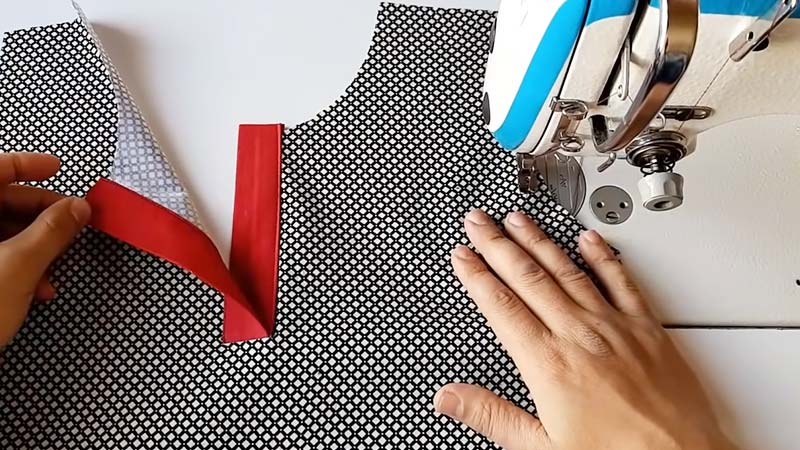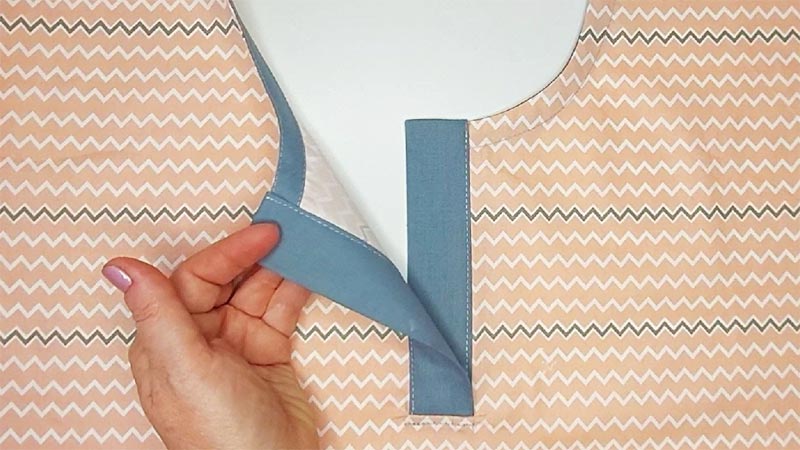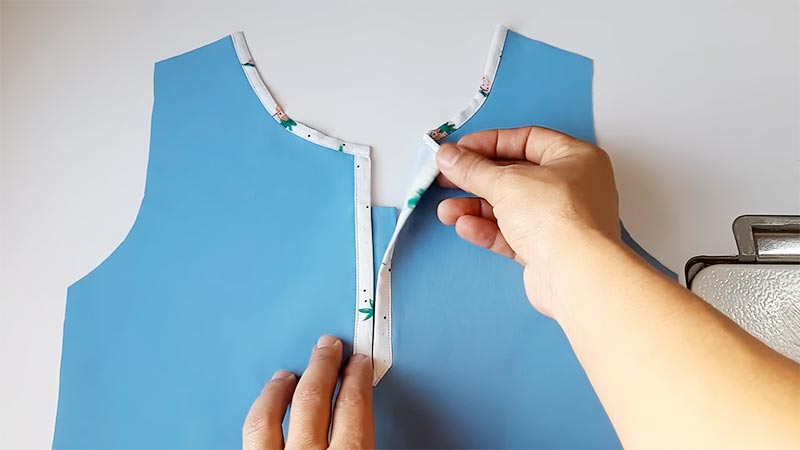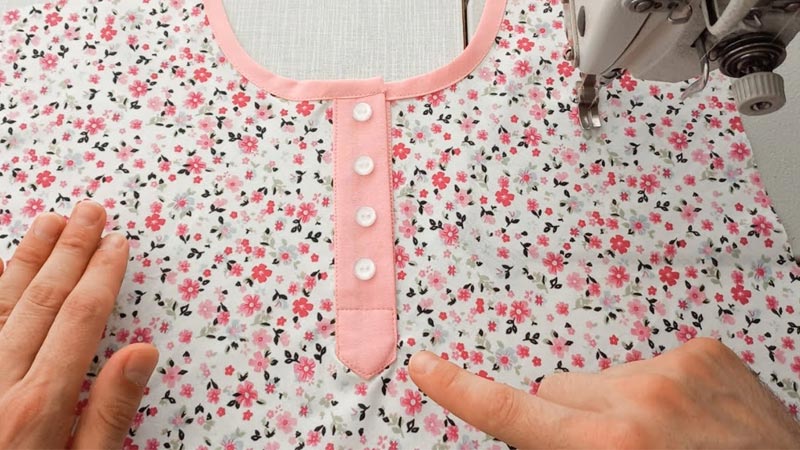In the intricate world of sewing, the term “placket” holds a vital role. A placket is not just a mere component; it’s a versatile and essential feature of clothing construction. It’s a carefully designed opening or slit that enables ease of dressing and secure closure in garments.
Whether you’ve fastened buttons on a crisp shirt, zipped up a jacket, or noticed a discreet, concealed closure on a formal dress, you’ve encountered the handiwork of a placket.
Plackets come in various forms, each tailored to specific functions, from neckline and sleeve plackets to front and waistband plackets. Beyond their utilitarian purpose, plackets also offer creative opportunities, adding both functionality and aesthetics to the art of sewing.
In this exploration, we’ll delve into the intricacies of what a placket is and how it contributes to the world of sewing.

What Is A Placket In Sewing?
In sewing, a placket is an opening or slit strategically incorporated into garments to enable easy dressing and undressing. Plackets are found in various clothing items, including shirts, dresses, skirts, and pants.
They serve both functional and decorative purposes. Common types include neckline plackets for easy head entry, sleeve plackets for cuff closure, front plackets for buttoned tops, and waistband plackets for pants and skirts.
Precision is crucial in placket construction, involving precise fabric cutting, folding, and often interfacing for reinforcement. Plackets can also be creatively designed with contrasting fabrics or decorative elements.
Mastering placket sewing is an essential skill for creating functional and aesthetically pleasing garments.
What Defines the Characteristics of a Placket in Sewing?

The characteristics of a placket in sewing are defined by its attributes and qualities that contribute to its function and appearance.
Key defining characteristics of a placket in sewing include:
Functionality
Plackets are designed to serve a functional purpose, primarily as openings or closures in garments. They make dressing and undressing easier while maintaining the integrity of the clothing’s fit.
Variety of Types
Plackets come in various types, such as neckline plackets, sleeve plackets, front plackets, and waistband plackets. Each type has specific features and is used in different areas of garments.
Design Element
Plackets can also serve as design elements in clothing. They offer opportunities for creative expression, as they come in various shapes, sizes, and fabric choices to enhance the overall aesthetics of the garment.
Reinforcement
Plackets are often reinforced with interfacing or stabilizing materials to provide structure, stability, and durability. This is particularly important when they feature buttonholes and buttons.
Tailoring Precision
Sewing a placket requires precision and attention to detail. Neatly finished edges, well-aligned closures, and accurate stitching are indicative of a well-sewn placket.
Versatility
Plackets are versatile and can be used in a wide range of garments, from casual wear to formal attire. This adaptability allows designers and sewers to create diverse clothing styles.
Simplicity or Elegance
Plackets can be simple and purely functional in basic garments or more intricate and elegant in formal or decorative clothing, adding sophistication to the overall look.
Professional Finish
A well-executed placket contributes to the professionalism and polished appearance of the final garment, regardless of whether it’s a homemade creation or professionally tailored.
What Are the Different Types of Plackets Used in Sewing?

In the world of sewing, plackets are essential components designed to serve both practical and aesthetic functions within garments. Plackets come in various types, each meticulously crafted to address specific needs and style considerations.
Here, we explore the different types of plackets commonly used in sewing:
Neckline Placket
Neckline plackets, positioned at the collar area of garments, enable easy passage of the head when dressing. They are a common feature in blouses, dresses, and shirts.
Neckline plackets can assume various shapes, including keyhole, V-shaped, or rectangular, and are chosen based on the design and ease of wear.
Sleeve Placket
Sleeve plackets are situated at the cuffs of sleeves and play a pivotal role in enabling the wearer to slide their arms comfortably through the sleeves and fasten them.
Different types of sleeve plackets, such as tailored, continuous, and bound plackets, are employed, each with distinct sewing techniques.
Front Placket
Front plackets are primarily employed in button-up shirts, blouses, and dresses. They create the opening and closure for the front of the garment, making it convenient to put on and take off the clothing.
The type of front placket chosen can vary, including standard, French, or concealed plackets, depending on the garment’s design and style.
Waistband Placket
Waistband plackets are a staple in the construction of pants and skirts. These plackets create an opening at the waist, facilitating the process of donning and doffing these lower garments.
Waistband plackets are typically found in fly-front pants and skirts equipped with closures like hooks, buttons, or snaps.
Continuous Placket
Continuous plackets are most often seen on cuffs or sleeves. In this design, a single piece of fabric is utilized for the entire placket, creating a continuous opening that can be secured with buttons or snaps.
French Placket
A French placket is a more formal and elegant version often used in men’s dress shirts. Unlike the standard placket, it doesn’t feature topstitching. The fabric is folded twice and stitched to the inside of the shirt, resulting in a clean, hidden finish.
Concealed Placket
Concealed plackets are chosen when a clean and smooth front is desired, hiding the buttons on a shirt. A separate piece of fabric covers the buttonholes and buttons, creating a seamless appearance.
What Are the Uses of a Placket in Sewing?

Plackets in sewing serve several essential functions that enhance the practicality and aesthetics of garments.
Here are the primary uses of a placket in sewing:
Ease of Dressing
Plackets create openings or slits in garments, making it easier for individuals to put on and take off clothing. This is especially valuable for garments with a snug fit or those without much stretch.
Secure Closures
Plackets are equipped with fasteners such as buttons, snaps, zippers, or hook-and-eye closures. These closures ensure a secure and reliable method of keeping the garment closed, preserving the desired fit and appearance.
Adjustability
Plackets on cuffs, collars, or the front of garments offer adjustability in the fit. Wearers can fasten or unfasten these plackets to accommodate different wrist or neck sizes, enhancing comfort and customization.
Ventilation
Plackets can serve as vents in some garments, allowing for improved airflow and temperature control. They are commonly found in items like polo shirts, enhancing comfort in warm weather.
Freedom of Movement
Plackets are often used in tailored garments to ensure that the wearer enjoys unrestricted movement. They prevent the fabric from constricting motion, making it easier to perform various tasks and activities.
Reinforcement
Plackets are typically reinforced with interfacing or stabilizing materials to provide structure, stability, and durability. This is particularly important in areas with buttonholes and buttons, ensuring they withstand wear and tear.
Closure Concealment
Concealed plackets are designed to hide fasteners beneath the fabric, creating a smooth and clean look on the garment’s surface. This is especially desirable in formal or dressy clothing.
Primary Closures
Front plackets on shirts and blouses, as well as plackets on pants and skirts, serve as the primary closures for openings in garments. They offer a secure means for the wearer to enter the clothing.
Versatility
Plackets are not confined to clothing; they also extend their utility to accessories like bags. Plackets in bags provide easy access and secure closure, ensuring the safety of belongings.
How Do Plackets Enhance the Aesthetics of Clothing?

Plackets play a versatile role in enhancing the aesthetics of clothing, adding both functional and decorative elements to the design.
Here’s how plackets contribute to the overall visual appeal of garments:
Creative Design Elements
Plackets come in various shapes, sizes, and styles, offering a canvas for creative expression. Designers and sewers can use contrasting or complementary fabrics, decorative stitching, or unique closures to make plackets visually interesting.
Contrast and Color
Plackets can be made from fabrics that contrast with the main garment, adding visual interest. This contrast can be in terms of color, pattern, or texture, creating focal points and accents.
Texture and Layering
Plackets can incorporate different textures and layering techniques. The use of lace, embroidery, or fabric appliqués can introduce tactile elements and depth to the garment.
Ornamental Stitching
Decorative stitching techniques like topstitching, embroidery, or even beadwork can be applied to plackets. This adds ornamental details that draw attention and enhance the overall design.
Symmetry and Alignment
Well-executed plackets are essential for maintaining symmetry and alignment in a garment. Misaligned or uneven plackets can detract from the garment’s aesthetic appeal, while precisely sewn plackets contribute to a polished look.
Contrasting Buttons or Fasteners
The choice of buttons or fasteners can impact the appearance of plackets. Contrasting or ornate buttons can serve as decorative elements, creating a focal point on the garment.
Concealed Closures
Concealed plackets, which hide fasteners under the fabric, create a sleek and clean look on the garment’s surface. This design approach is often favored in formal or dressy clothing, contributing to a minimalist and elegant appearance.
Framing and Emphasizing
Plackets can frame specific areas of a garment, such as the neckline or cuffs. This framing effect draws attention to these areas, emphasizing them as design features.
Consistency and Cohesion
Plackets that are well-integrated into the garment’s overall design contribute to a cohesive and harmonious look. They should seamlessly blend with the garment’s style and design, creating a unified appearance.
FAQs
What functional roles does a placket serve in sewing?
A placket in sewing provides functional roles of facilitating dressing, secure closures, adjustability, ventilation, freedom of movement, reinforcement, and comfort in garments.
Why are well-sewn plackets important in sewing?
Well-executed plackets are a hallmark of quality craftsmanship. They provide a professional finish, ensuring both functionality and a polished appearance in garments.
Can plackets be added to existing garments as a modification?
Yes, plackets can be added to garments, but it can be a complex process. It’s often best handled by experienced seamstresses or tailors.
What is the history of plackets in fashion and garment construction?
Plackets have a long history, with variations found in clothing from various cultures. They’ve evolved from simple slits to more complex, decorative elements over time.
What is the significance of interfacing in placket construction?
Interfacing adds stability to the placket, preventing it from stretching or distorting. It’s especially important when dealing with buttonholes and buttons.
To Recap
In the intricate tapestry of garment construction, the placket emerges as a small yet mighty thread that weaves together functionality and aesthetics.
As we conclude this exploration into what a placket is in the world of sewing, we find that this unassuming feature plays a pivotal role in our daily attire.
From the simple convenience of easing into a shirt to the security of closures in our favorite jackets, plackets facilitate our dressing rituals. Moreover, they allow for creative expression, serving as design elements in the world of fashion.
The placket stands as a testament to the meticulous craftsmanship that goes into every piece of clothing, a reminder that even the smallest details can make a world of difference in the art of sewing.
Leave a Reply